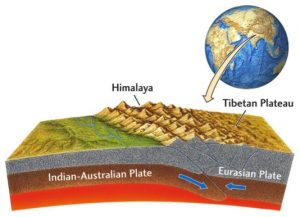
One of the most important theory of Geo morphology is the Plate tectonic theory. The plate tectonic theory has explained following things:-
(1) Why most of the fold mountains are found at the margin of the continent margin ? Only exception is the Himalayas which is not found at the continental margin.
(2) The formation of volcanoes , earthquakes, island etc.
(3) Pacific ring of fire.
Thanks to the plate tectonic theory because of which the formation and mechanism behind the above mentioned points could only be very well understood. In this section we will come to know about the formation of Himalaya.
If we try to analyse the location of Himalaya through map/Atlas book . We will come to know that the Himalayas lies at the interior not at margin of the continent. The formation of Himalaya could be explained by the plate tectonic convergent plate boundary theory. According to the convergent plate boundary theory, the two converging plate collides. Due to this collision the heavier plate subduct over the lighter plate. This will led to formation of subduction zone. The collision of two plates may led to formation of Volcanoes, Earth quake and Fold mountains. The collision of plates exert tremendous amount of compressive force , which is capable of folding the crust around the colliding plates.
Now coming back to the Himalayas again, as it is stated above that the formation of Himalaya is because of convergent plate boundary. Now try to visualise the situation , due to the drifting of the Indian plates towards north as clearly explained by Wegner in his theory of continental drift. At some point, the tectonic plates of Indian peninsular collided with that of Eurasian. The collision was so intense that intense compressive force has led to the folding in the region of collision. Thus, led to the formation of the Himalayas. Remember , still the Indian plate is colliding with the Eurasian plate because of this the height of Himalaya is increasing by more than 1 cm per year . Due to the collision of both the plates the Indian plate which is a heavier one has not subducted completely. The Eurasian plates rest over the Indian Plates, this has led to the doubling of earth crust beneath the Himalayas . The earth crust beneath the Himalaya is approximately 60- 70 Km thick . The crust is so thick that in entire Himalayan region there is absence of Volcano but, severe earth quake prone region because the region is tectonic unstable because of the collision between Indian and Eurasian plates.



